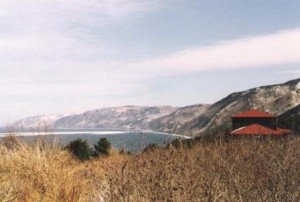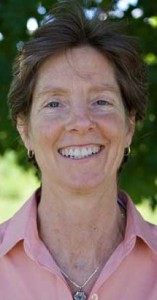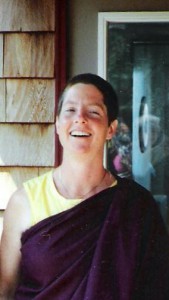Sunday
Atlantic Canada, Featured Stories, International ProgramsLife, Death & Three-year Retreat

The cliffs of Cape Breton rise behind the Rigden King in this detail of a thangka by Gregory Smith. Photo courtesy of Gampo Abbey.
Sharon Keegan shares how personal experiences of impermanence led her into a three-year retreat, and guided her activity in the world when she emerged. Be sure to read the fifth article or click here to view the entire series.
A longish story made shorter: I met the buddhadharma early on in my life and am now a Shambhala Vajrayana Buddhist, thoroughly committed to the stages of our Shambhala Path contained within the Scorpion Seal teachings. I am also presently the administrator of Vermont Respite House, a hospice residence in Williston, Vermont.
My practice path started with meeting the Vidyadhara Chogyam Trungpa Rinpoche at Naropa Institute in 1978 and eventually led me to our sangha’s first three-year retreat program. I completed the retreat in 1996 as a member of “Group A” at Sopa Choling, the retreat center of Gampo Abbey in Pleasant Bay, Nova Scotia.
My time at Sopa Choling was powerful and fruitful. The retreat container provides undistracted immersion of one’s body, speech and mind in the dharma, supporting one to experience the nature of one’s mind on a profound level. I believe my life presently reflects the benefits of such concentrated training in those noble retreat practices, which have been personally practiced and blessed by generations of great Kagyu and Nyingma meditation masters. As is often said, the three-year retreat is an on-going practice that does not stop when retreat is over. I continue to explore and expand from that strong foundation.
I feel this clearly on the Scorpion Seal path, which is stabilized and energized for me by the thoroughness of my three-year retreat training. The guru yoga practices of retreat awakened my appreciation for our teachers; my heart opens to the authentic presence and guidance of Sakyong Mipham Rinpoche. The sadhanas of retreat familiarized me with visualization and gave me confidence in its power to transform. And the many hours spent working with formless meditation allow me to connect with the profundity and brilliance of the Shambhala teachings. At Sopa Choling we made the aspiration over and over to be of benefit to others. Lovingkindness blossoms on retreat; now it fuels my work in the world.
 All along, the threads of my family experience have interwoven with my practice journey. It began simply enough: I was in the eighth grade when an elder sister brought home a book from her religion survey class, newly offered at our Catholic high school. By chance I picked it up from our coffee table at home. Essentials of Buddhism was a short and pithy read. A little later on, the same sister, now in her college life, presented another read, Siddhartha by Hermann Hesse. The content, which reflected on existential suffering and quest for truth, felt so true. It was positively refreshing to consider that our original wholeness and wisdom are simply obscured rather than fundamentally flawed, and that there is a path for reconnecting to this essential love and wisdom, as presented by a noble chap more than 2500 years ago by the name of Siddhartha—later known as the Buddha, the Awakened One.
All along, the threads of my family experience have interwoven with my practice journey. It began simply enough: I was in the eighth grade when an elder sister brought home a book from her religion survey class, newly offered at our Catholic high school. By chance I picked it up from our coffee table at home. Essentials of Buddhism was a short and pithy read. A little later on, the same sister, now in her college life, presented another read, Siddhartha by Hermann Hesse. The content, which reflected on existential suffering and quest for truth, felt so true. It was positively refreshing to consider that our original wholeness and wisdom are simply obscured rather than fundamentally flawed, and that there is a path for reconnecting to this essential love and wisdom, as presented by a noble chap more than 2500 years ago by the name of Siddhartha—later known as the Buddha, the Awakened One.
My parents died when I was in my twenties. First, my mother developed cancer and went from diagnosis to her death in six weeks. I had taken refuge vows shortly before. I cared for her, amidst letting go of any ambition for what reality ought to be. Her final breath and the “gap” of no more breath introduced me to non-conceptual mind. Thinking of the long retirement my parents had anticipated sharing, my father said tearfully, “This wasn’t how it was supposed to be”– a statement that propelled me not to take “later” for granted. I sat a dathun the next month.
My father was diagnosed with leukemia two years later. Although a short illness was predicted, he lived for two years. I returned home and attended him, while also doing ngondro. This was further training in letting go of expectations, further familiarization with death and dying while offering comfort to someone I loved.
Afterwards, I sought advice from Khenpo Karthar Rinpoche, relating to him that I had attended to both of my parents in their final days and dying process. My question for Rinpoche was: What is the most meaningful use of my life at this point? With great kindness, he said, “I am so sorry for your loss. Obviously you have connected deeply with the truth of impermanence. You should do a three-year retreat.”
I wasn’t particularly eager to learn Tibetan in order to do the retreat. The timing was perfect when soon after, Gampo Abbey declared its intention to follow both Trungpa Rinpoche’s wish to establish such a practice in our Shambhala community and Khenchen Thrangu Rinpoche’s recommendation that the Abbey should build a three-year retreat center. Thanks to our Nalanda Translation Committee, this retreat would be done in the English language. What a gift that was! I fulfilled the retreat requirements, was accepted and entered Sopa Choling, clearly knowing that whether I died very soon or later, this was the best use I could make of this precious human life. I am deeply grateful that the causes and conditions of my life came together to support me in completing it.After the retreat I stayed on in Cape Breton for three more years, having been asked to serve as Gampo Abbey’s first lay administrative director. During this time an inspiration was brewing: I wanted to start a residential hospice—a care facility devoted solely to the needs of the dying and their families. This seemed a natural way to join personal family history and administrative experience. Confidence and conviction were also necessary in order to step out in this way: these were instilled in me by the profound instructions I had received in retreat on taking the transitions in life, both small and large, as opportunities for awakening.
In Halifax, I found eager and noble allies in our Shambhala community, as well as among some passionately concerned local citizens. The Hospice Society of Greater Halifax was given birth in 2001. It still exists, offering services to the community and working toward its mission of creating a dedicated hospice facility.
Shortly after, when I moved to Burlington, Vermont, I discovered that exactly what I had envisioned already existed in nearby Williston in the form of Vermont Respite House. In 2003 I became administrator of that thirteen-bed residence. Here, my ongoing aspiration and activity are to encourage an “enlightened” care-giving community by recognizing natural basic goodness in residents, their family and staff. The environment acknowledges the sacredness of the experience of death and dying, while celebrating all the textures of living. Several sangha members have been among our patients. It feels very special to work with sangha, like coming full circle.
As I attend to both administrative and direct care of the dying and their families, my three-year retreat training contributes daily to my ability to manifest the fearlessness, spaciousness and ordinary magic that is needed to work with life’s more challenging transitional times, which we call death—and administration!
__________________________
 Sharon Keegan is active at the Burlington Shambhala Center as a teacher and meditation instructor. Information about Vermont Respite House is available on their website. Sharon’s advice to readers of her story: If you feel drawn toward intensive practice, don’t shy away — leap into it!
Sharon Keegan is active at the Burlington Shambhala Center as a teacher and meditation instructor. Information about Vermont Respite House is available on their website. Sharon’s advice to readers of her story: If you feel drawn toward intensive practice, don’t shy away — leap into it!
SOPA CHOLING ANNOUNCES A NEW THREE-YEAR RETREAT CYCLE
Empowerments scheduled for August 2011 for group and solitary retreatantsInquiries and applications are now being invited for Group G, the next three-year retreat cycle at Sopa Choling, which is expected to begin in Fall 2012. Ven. Thrangu Rinpoche will visit Gampo Abbey in August 2011 and bestow the empowerments associated with the retreat practices. The empowerments are required for those who plan to attend all or part of the Sopa Choling retreat and, for the first time this year, they are also open to those who have an interest in doing these practices on their own. The prerequisite for these programs is prior receipt of the Vajrayogini abhisheka.
Sopa Choling is the retreat facility of Gampo Abbey, situated in a remote location of great natural beauty at Pleasant Bay, Nova Scotia. For information about the empowerments of August 2011 and the retreat beginning in 2012, contact Retreat Master Nancy Huszagh at [email protected]. See also Sopa Choling’s website.






Jan 31, 2011
Reply
Thanks for sharon (pun intended) your story, very generous and inspiring!